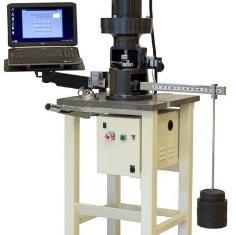WHY TIMKEN OK LOAD RATINGS SHOULD NOT BE A PRIMARY MEASURE OF EP PERFORMANCE
When reviewing the technical data sheet for a lubricant or lubricant specifi-cations for a piece of equipment, you will often see references to the Timken OK Load test. So what does it mean when one lubricant has a 35-pound Timken OK Load rating and another has a 100-pound Timken OK Load rating?
The truth is … it may have very little relevance to the amount of EP protection you are getting.
There are basically three reasons for this:
- First, the Timken Test Machine was designed in 1935 and manufac-tured until 1972 by the Timken Bearing Company. Timken used the machine to confirm that extreme pressure chemistry in cutting oils they were using to manufacture bearings was still working. It was never designed to quantify performance in any terms other than pass or fail with a 35-pound (188,250 PSI) load applied. Large wear scars or scoring represented a fail and smooth scars were a pass.The test was subsequently adopted by the industry when Timken began selling the machines and the American Standards Testing & Materials published the ASTM D-2509 procedure for testing greases and ASTM D-2782 for testing oils. From that point on manufacturers started competing for bragging rights to the highest Timken OK Load rating and the Timken OK Load test became a marketing tool more than a simple indicator of the presence of EP additives.The Timken Bearing Company has attempted to clarify the misun-derstanding about the test with this statement, “It was generally assumed that the higher the O.K. value, the more load the lube could hold without the film strength being compromised. However, this is not necessarily the case, and the primary purpose of the test is to determine whether or not the lube has an EP additive. Values higher than 35 lbs. indicate the presence of an EP additive.”
- Second, there are certain EP additives that can be added to lubricants to give very high Timken results. But no correlation has ever been established between these extraordinarily high Timken OK Loads and actual field performance. In fact, some of the additives that produce such high Timken OK Loads can be corrosive and/or hazardous and may damage the equipment they are formulated to protect.
- Third, in terms of scientific testing, the Timken OK Load test has very poor repeatability and thus a wide margin of error. In fact, the official ASTM D-2509 Timken test procedure states that the results from one test to the next of the same lubricant on the same Timken machine can vary as much as plus or minus 23%. That means a lubricant that gets a pass rating at 60 pounds could actually be anywhere from a 46-pound load to a 74-pound load. If the same product is tested on a different machine, the rating can be off by plus or minus 59%, which means it could actually be anywhere from a 25-pound load to a 95-pound load. The poor repeatability of the test makes it possible for a manufacturer to repeat the test until the highest result is found and claimed. There are also many “modified” versions of the Timken machine used by some marketers to “demonstrate” load carrying properties; these are not accepted tests for determining EP properties as the results can be easily manipulated.
Today, most industry professionals agree that the Timken Test should only be used to indicate whether EP agents are present without implying anything about relative performance levels. And most OEM’s now specify more relevant tests that have proven direct correlation to actual field experience, such as the 4 Ball EP Weld, FZG Gear Tests and others. To indicate precisely how much EP and anti-wear performance they require of a lubricant.
So, how much EP is enough? What if, grease “A” quotes a 100 lb. Timken OK Load pass rating and a 400 kg 4-Ball Weld Load. Grease “B” quotes a 60 lb. Timken OK Load pass rating and an 800 kg 4-Ball Weld Load. Which one would perform better in extreme pressure applications? The Timken OK Load ratings tell you that both greases have EP chemistry. But the 4-Ball Weld tells you grease “B”, even with the lower Timken OK Load rating, has the more effective EP chemistry.
Remember when evaluating lubricants based on EP chemistry that more is not necessarily better. If an application doesn’t really require extreme EP performance, your customer could be paying for more protection than they really need.
SWEPCO provides Timken test results not to impress, but to show that EP additives are present and functioning. Generally, a value above 35 lbs (which is equivalent to an extreme pressure of 188,250 psi at start of the test) will adequately protect most equipment.
So, don’t let extreme Timken OK Load ratings overly influence the selection of lubricants. Actual field results, other EP tests and performance tests, such as corrosion resistance and wear, have far greater relevance in most applications.
Source: SWEPCO®


